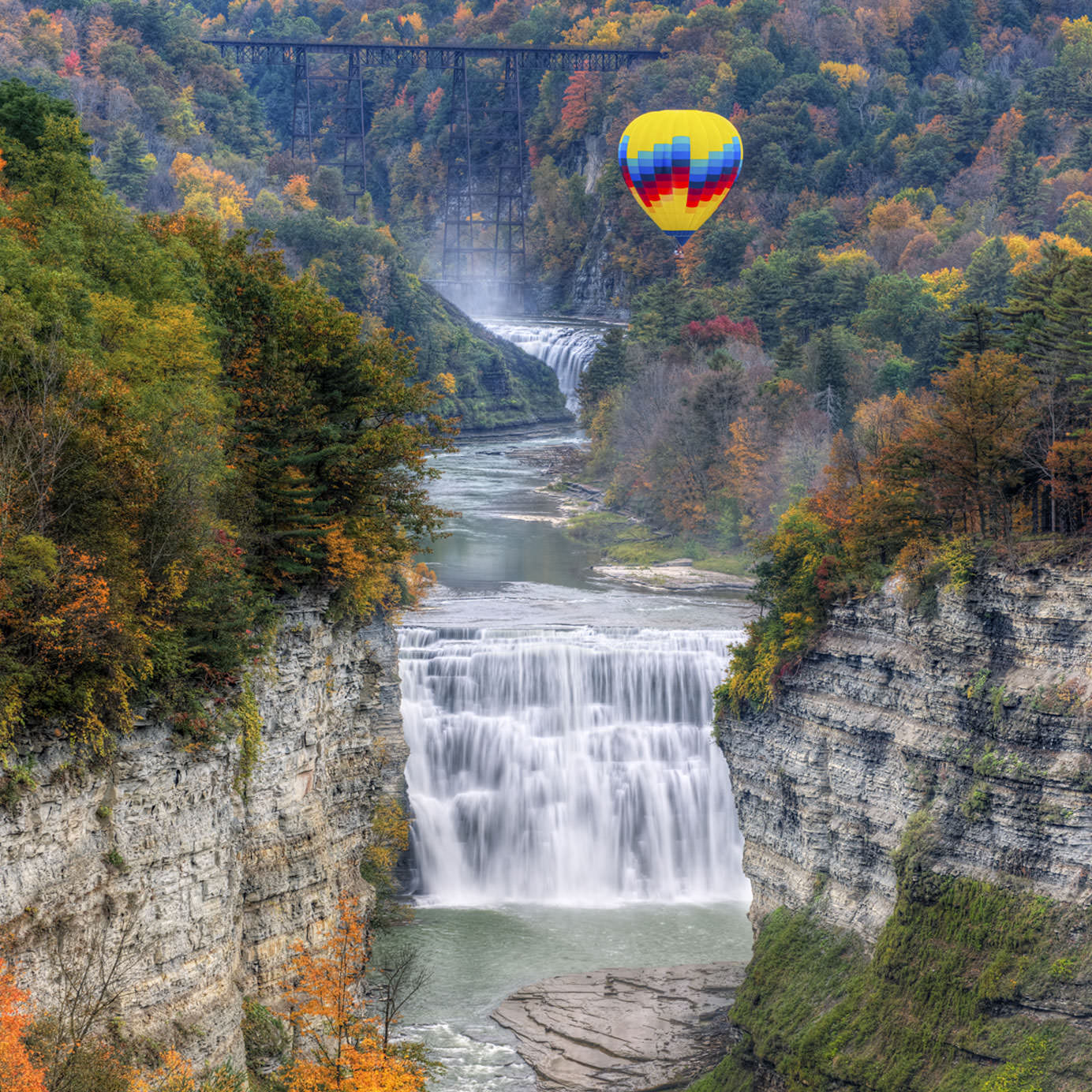Located five hours outside New York City, in the Southern Tier region of New York State, sits the most exciting wine region on the East Coast, the Finger Lakes. While the North Fork of Long Island may receive more attention, due to the region’s proximity to NYC, the Finger Lakes consistently produces world-class wine.
The area didn’t exist as a winemaking destination until the 1960s, when Dr. Konstantin Frank established his eponymous winery and began growing Riesling in Hammondsport, N.Y. Frank’s commitment to the grape, and the region’s wide-scale adoption of its cultivation, has turned the Finger Lakes into one of the greatest Riesling regions of the world. The area’s signature wine, combined with a burgeoning food and craft beer scene, makes now the perfect time to visit.
What to Know
The glacial Finger Lakes region takes its name from early Iroquois mapmakers who, when examining 11 thin and very long lakes in the Southern Region of New York, felt they resembled two hands that had been placed on the earth. The lakes were a result of their fingers’ impression on the soil.
Don't Miss A Drop
Get the latest in beer, wine, and cocktail culture sent straight to your inbox.When Frank came to the region to work at Cornell’s Geneva Experiment Station in the 1950s, he saw some similarities among New York’s landscape and the Eastern European regions where he had previously worked. They, too, were cold, but grapes like Riesling had thrived.
At the time, the Finger Lakes region was primarily growing American grape varieties, such as Concord and Catawba. They produced drinkable table wine, but nothing worth international attention. Frank figured that the lake effect — wherein a body of water retains summer heat year-round, warming the surrounding earth even in the winter — would allow for the planting of certain European varieties, including Riesling. He knew that those varieties were the perfect fit for the climate and warm, short summer. The rest is history.
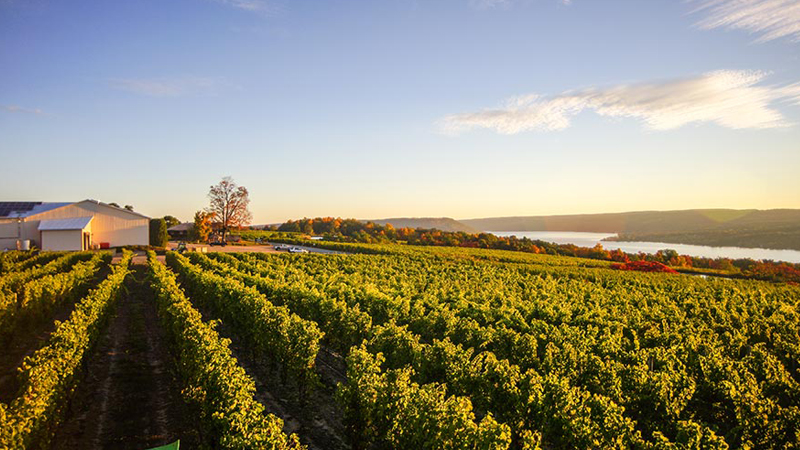
Where to Go
There are 11 lakes in the Finger Lakes region, but wine production is focused in only three of them: Keuka Lake, where Frank built his winery; Cayuga Lake, where Ithaca and Cornell sit at the southern tip; and Seneca Lake, the largest lake in the Finger Lakes system and the one that’s now widely considered by winemakers to have the region’s best terroir.
Visiting all three in a day would be quite the undertaking, even though they sit side by side. A better move is to tackle one lake at a time. If time is tight, focus on Keuka and Seneca, where the best wine is being produced.
There are several wonderful towns in the region, but your best bet is to make Ithaca, Watkins Glen, or Geneva your home base. Ithaca has a college town vibe, with restaurants and bars that are filled with students at night. Watkins Glen is great for active travelers, as it easily accesses hiking trails along the Gorge and is a good jumping-off point for those who hope to spend time on Seneca Lake. Geneva is ideal for those looking for a hipper vibe. Over the past few years several former Brooklynites have come to the area, setting up hotels, restaurants, and coffee shops.
Keuka Lake
Start your visit where it all began, Dr. Konstantin Frank Winery, on the west side of Keuka Lake. Frank’s family continues to operate the winery, and several of the best winemakers in the region got their starts here.
One of the first things you’ll realize during your visit to this and every other winery in the Finger Lakes is that, contrary to popular belief, Riesling is not always sweet. Yes, there are some styles of Riesling that can have a good amount of residual sugar — wines made for the end of the meal — but the vast majority of high-quality, ageable Riesling is dry, refreshing, and very pleasurable.
In addition to producing great Riesling, Frank’s winery was one of the first to make sparkling wine. Make sure to sample that as well, and maybe pick up a case or two.
Next, head to two young wineries run by Frank’s former employees, Weis Vineyards and Domaine LeSeurre. They are conveniently located right next door to each other.
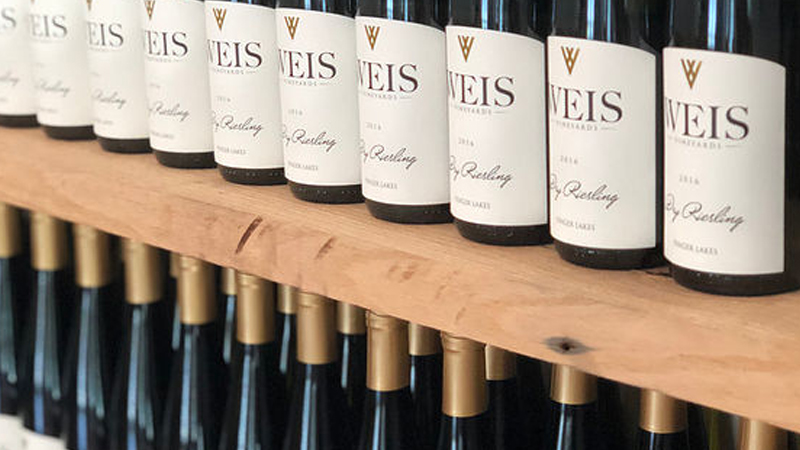
At Weis Vineyards, the tasting room is situated in a former one-room schoolhouse. Owners Ashlee and Hans Peter Weis met in the region; Weis had come to the Finger Lakes from his family winery in the Mosel region of Germany to gain winemaking experience. As a Mosel native, Weis feels a strong connection to Riesling. He found the terroir of the Finger Lakes unique and exciting. During your visit make sure to taste not only the Riesling, but the excellent Gewürztraminer as well.
Domaine LeSeurre is owned by young winemakers Céline and Sébastien LeSeurre, who were both born and raised on vineyards in their native France. They are incredibly fun, geeky winemakers who believe the best terroir of the region has yet to be discovered, and are constantly trying grapes from different vineyard sites and using different oak compositions and toast levels in their barrels in pursuit of quality. The most exciting and surprising wines here are not the Rieslings (though they are very good), but rather the Cabernet Francs. The Finger Lakes are awash in Riesling, but Domaine LeSeurre proves excellent, ageable reds can thrive here as well.
Seneca Lake
If you only have time for one day of visits and tastings, make sure they’re on Seneca Lake. Your first stop is Herman J. Wiemer, the region’s best winery, for a sampling of its stellar single-vineyard Rieslings and sparkling wines. Like Dr. Frank, Herman J. Wiemer was one of the founders of the region, emigrating from Mosel, Germany in the 1960s and establishing both a winery and a nursery in New York State. In 2003, Wiemer’s apprentice, Fred Merwath, took over the winery and brought on his Cornell college friend, agronomist Oskar Bynke, as co-owner.
Together the two are making the region’s most exciting wines. While they do not refer to their wines as “natural,” their entire process could be classified as such. No pesticides or herbicides are used in the vineyards, and the wines are naturally fermented in the winery, with fermentation often taking eight months or more. Merwath believes this slow fermentation is essential for creating complexity and depth of flavor in his Rieslings, and it is apparent in the results.
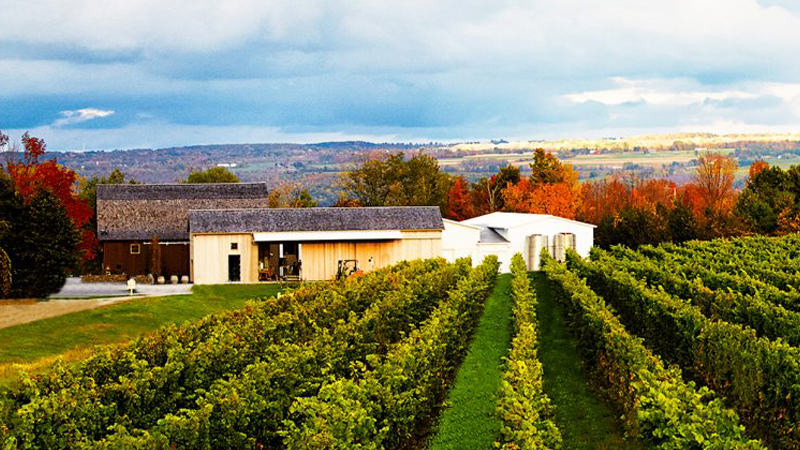
After visiting Wiemer, drive around to the east side of the lake to Boundary Breaks. On your way you may want to stop in Geneva at Monaco’s Coffee for some much-needed quality coffee and a bite to eat.
Boundary Breaks is a younger winery but probably the region’s fastest-rising star. Founded by Bruce Murray and his wife Diana Lyttle, the winery was built as close to Seneca Lake as possible in order to fully take advantage of the lake effect. Drainage tiles were installed under the entire vineyard to reduce moisture and force the vines to struggle, thereby producing higher-quality fruit. Boundary Breaks produces wines that are drinkable now, but also some options that you’ll want to cellar. Its Dry Riesling #239, named for the Riesling #239 clone that’s used to make the wine, is stunning, a beautiful balance of ripe fruit and bright acidity. The winery also makes some of the area’s best sweet, late-harvest Riesling; make sure to taste the Spätlese-style #198. It’s a lower-alcohol wine whose sweetness is balanced by wonderful acidity, making it ideal for pairing with spicy food.
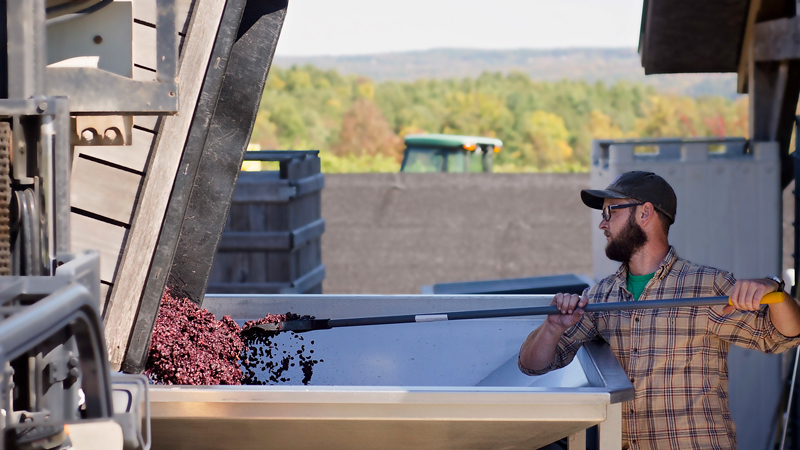
If you find yourself in the mood for red wine, make your last stop of the day Hickory Hollow, back on the west side of Seneca Lake. It serves as the tasting room for Nathan Kendall’s N. Kendall wines, and proves that good Pinot Noir can indeed be made in the region.
Kendall is also collaborating with Pascaline Lepeltier, Master Sommelier and champion of the natural wine movement, to create a Pet Nat using first-generation hybrid grapes from the Finger Lakes. He’s a smart, geeky winemaker whose wines are worth checking out.
If you’d rather stick with white — this is the country’s preeminent Riesling region, after all — stay on the east side of the lake and head to Standing Stone. It was recently purchased by Fred Merwarth and Oskar Bynke of Herman J. Wiemer. They are completely turning the winery around. Located on some of the most beautiful property in the region, Standing Stone is producing deliciously refreshing dry Riesling. You’ll also have the opportunity here to taste Saperavi, a dark, almost black, Georgian variety that was planted at the Standing Stone vineyard decades ago.
… And Beyond
If spirits are more your thing, Finger Lakes Distilling produces great bourbon and rye.
If you’re more in the mood for beer, make sure to head to Two Goats, Lucky Hare, and Climbing Bines, all located on Seneca’s east side. Be forewarned, though, that breweries can get extremely crowded, especially on nice days in the late afternoon, when a lot of people have had their fill of wine tasting for the day.
Finally, if you’re staying in Ithaca or want to check out the third lake, Cayuga, don’t miss Heart & Hands Wine Company. The action over on Cayuga is less than what goes on around Seneca or Keuka Lakes, but, if you’re a big fan of Pinot Noir, this is a producer that should not be missed. If everyone in the region were producing Pinot of this high quality, it might force the region to reevaluate Riesling as its preeminent grape.
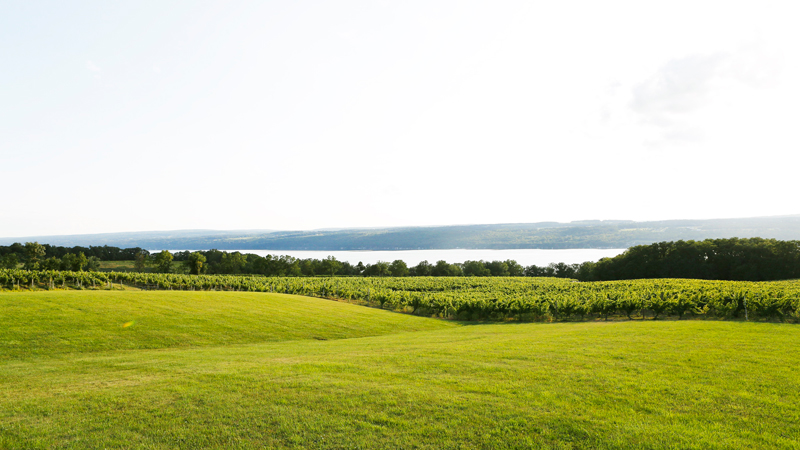
Where to Eat
Graft Wine + Cider Bar
At this casual eatery in downtown Watkins Glen, where most people sit at a long bar, the drinks are all made in New York State, and the farm-to-table cuisine is outstanding. The staff knows its New York beer, wine, and cider, and are happy to help you pair it with the menu. Don’t miss the fresh pie if it’s available.
Hand + Foot
The most exciting restaurant in the region, Hand + Foot was founded by New York City restaurant industry veterans who returned to upstate New York to start a family. The cocktail list and wine selection here are amazing and the food is insanely inventive. Do not miss anything involving Korean rice cakes; other highlights include the Hippie Be Goode sandwich and the fried pickles and pearl onions.
Stonecat Cafe
At this more formal establishment, everything on the menu is fresh and in season and hails from farms around the region. The restaurant serves as something of a winemakers’ hangout, too, so you may bump into some people you met at the day’s tasting at the bar.
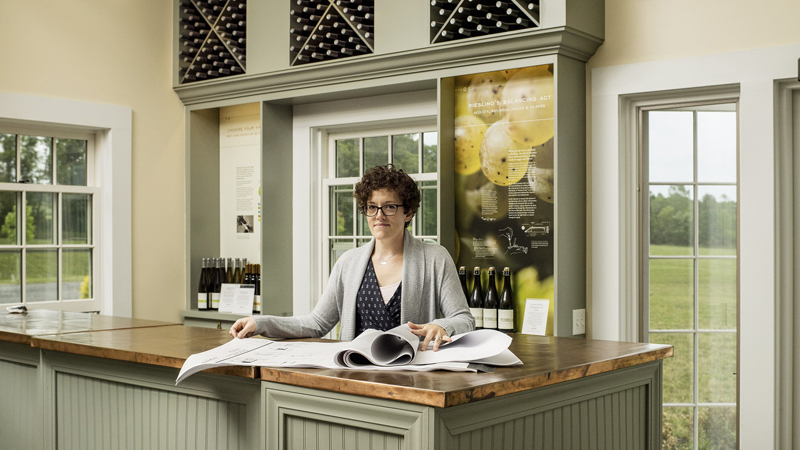
Where to Stay
Watkins Glen Harbor Hotel
Located in Watkins Glen on the southern tip of Seneca Lake, this is a large hotel with nice, clean rooms. The lovely patio overlooks the water and is the perfect place to have a drink and watch the sunset.
Belhurst Castle and Winery
Located on the northern part of Seneca Lake, near Geneva, this hotel has a winery, a brewery, and a spa on the property. It’s the closest to a Napa experience as you’ll get in the Finger Lakes.
Airbnb
Several stellar properties are often available on this platform, some of which have jaw-dropping lake views and provide the opportunity to cook and entertain.
When to Go
The Finger Lakes is a beautiful place to visit in the late spring, summer, and fall, when temperatures are warm and everyone is out on the lakes. Winters can be brutal, though, with heavy snow and below-freezing temperatures for months on end.
